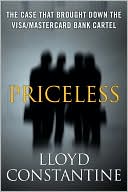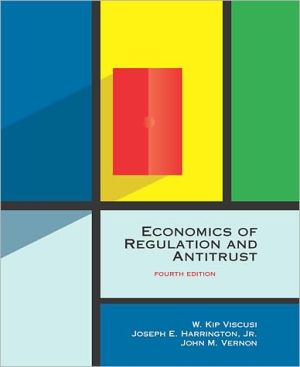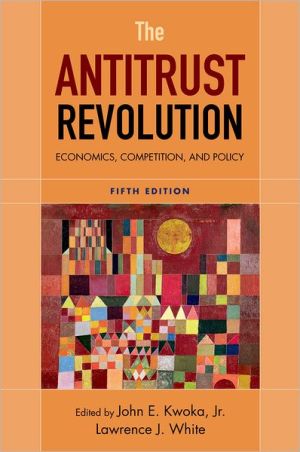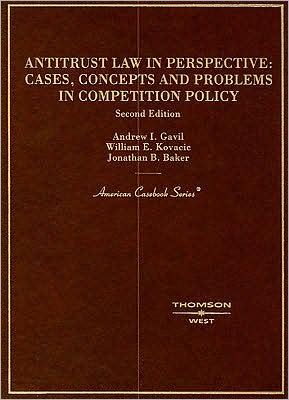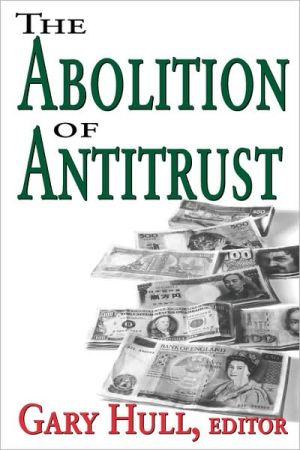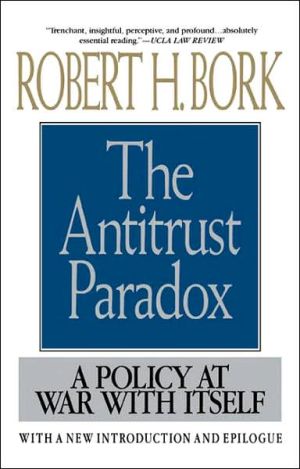EC Competition Law
The development of competition law in the EU can be explored through three interrelated perspectives: the extent to which controversies in economic thinking affect the design of the law; how changing political visions about the objectives of competition law have caused shifts in the interpretation of the rules; and the institution in charge of applying the rules. The economic and political debates on competition law show that it is a contested terrain, and the way courts and competition...
Search in google:
Monti explores the development of EC competition law through an interdisciplinary approach.
Cambridge University Press\ \ 9780521700757 - EC Competition Law - by Giorgio Monti\ \ Excerpt\ \ \ \ \ \ \ 1\ \ Competition law: policy perspectives\ Contents\ \ \ 1\ Introduction\ page 1\ \ \ 2\ A case study: the de Havilland decision of the European Commission\ 6\ \ \ \ 2.1\ Politics\ 8\ \ \ \ 2.2\ Economics\ 9\ \ \ \ 2.3\ Institutions\ 13\ \ \ 3\ The demands of a workable competition policy\ 15\ \ \ \ 3.1\ Predictability and a narrow approach to competition law\ 15\ \ \ \ 3.2\ Rules and standards\ 16\ \ \ 4\ Conclusion\ 18\ \ \ 1 Introduction\ The European Community’s commitment to promoting competitive markets was a significant step when the EEC Treaty was agreedin 1957 because European economies had seen high levels of state control, legal cartels and protectionist policies.1 Today, the EC’s faith in the market is firmly established as the Community’s economic policy is ‘conducted in accordance with the principle of an open market economy with free competition’.2\ In a market economy, the consumer, not the state, dictates what goods and services are provided. Consumer demand drives production. Even if consumers are truly sovereign, however, a market economy will not eliminate all inefficiencies: scarcity means that society is unable to satisfy everyone’s demand. Accordingly, competition law is not designed as a highly interventionist policy to guarantee the welfare of every segment of the economy, nor is it designed to compel or create incentives for firms to behave to promote economic welfare. Its aim is more modest: to condemn anticompetitive behaviour. In the Community, Article 3(1)(g) EC provides that the EC shall have ‘a system ensuring that competition in the internal market is not distorted’. The system put in place by the EC Treaty provides for three principal rules to protect competition, which are addressed to firms: prohibiting firms from entering into agreements restrictive of competition (e.g. a price-fixing cartel); prohibiting dominant firms from harming the competitive process; prohibiting mergers that may harm competition. The rules are, in large part, enforced by the European Commission, with a dedicated Directorate General for Competition in charge of the operational tasks. The Treaty also imposes a number of obligations on Member States to reduce barriers to trade, which complement competition policy by creating a single European market.\ It is not possible to go beyond these trite remarks about competition law without saying something controversial. For example, it is hard to provide a definition of ‘competition’ everyone will agree with, or to obtain consensus about the reasons for having competition law. The controversies over the role of competition law in regulating markets have been expressed in especially colourful language in the United States, with Professor Fox concluding that there is a ‘battle for the soul of antitrust’.3 The battle has been fought vigorously in academic journals but also in the courts. In some leading Supreme Court cases the clashes between plaintiff and defendant have often included eminent economists and law professors representing either side depending on their views of the purposes of competition law.4 The controversies have been no less poignant in Europe: one author who observed the workings of the European Commission reported that ‘fighting over competition policy was … endemic’.5\ In entering this battlefield for normative supremacy, this book takes the following position: it is impossible to identify the ‘soul’ of competition law; the most that can be done is to show that there are different, equally legitimate opinions as to what competition law should achieve. Moreover, within each country, the purposes of competition law can change over time, even without an amendment to the legislative texts. This is possible because of the open-textured nature of most antitrust legislation, which allows for considerable variety in interpretation. Understanding competition law thus is not only about dissecting legislative texts and judicial decisions according to settled canons of interpretation, but is also about understanding the particular forces that have influenced the direction of competition policy at particular times.\ Professor Bork took a similar view. In his influential book The Antitrust Paradox, he opined that ‘[a]ntitrust policy cannot be made rational until we are able to give a firm answer to one question: What is the point of the law – what are its goals? Everything else follows from the answer we give … Only when the issue of goals has been settled is it possible to frame a coherent body of substantive rules.’6 However, in contrast to Bork’s certainty about the possibility of answering that question, the position taken here is that while it is true that any specific decision in a competition case requires a prior resolution as to the aims of the law, to date no competition authority has deployed competition law in accordance with one unchanging set of aims – the goals of antitrust vary over time; even at the same time, the law can be pursuing different, even mutually contradictory, goals. The best way to understand competition law’s evolution and its future is to gauge how differing answers to Bork’s questions have arisen and how they have affected the shape of individual decisions and the direction of law.\ As a result, before moving to consider the substantive rules, it is important to have an idea of the variety of aims which competition law enforcement might pursue. The body of rules we call ‘competition law’, and each decision reached, reflects a particular vision of what competition law is designed to do, or a compromise, which reflects the tensions among law makers as to the purposes of a particular rule. Only by understanding from which premises a particular rule or decision is coming can one then subject it to informed review. It is too simplistic to state that a decision is wrong because the person enforcing competition law got the ‘economics’ wrong when there is no consensus among economists as to what the right economic perspective is. Moreover, a decision might be economically irrational under any standard, but might be supported by political values that are widely respected.7 Thus, competition law can be best understood, and subsequently criticised, if one views the rules as a function of a number of considerations that animate its development.\ In my view, it is helpful to think about the factors that influence the shape of competition law and the decisions that stem from those rules on the basis of the interaction of three components: a political decision about the aims of competition law; an economic theory about how markets behave, how and when they fail, and how market failures may be remedied; and the institution in charge of enforcing competition law.\ When answering the political question, two extreme answers might be offered: either competition law is solely about promoting economic welfare by ensuring that firms behave in such a way as to minimise costs and maximise the benefits that consumers can obtain from the scarce resources that are available (in economic terms, the pursuit of productive, dynamic and allocative efficiency), or competition law can be used to pursue a variety of other public interest goals, for example to maximise economic freedom, preserve employment, promote national champions, facilitate restructuring, protect small firms, safeguard cultural values, conserve the environment, and so on. In between these two extremes of competition law as ‘guardian of economic welfare’ and as ‘instrument of public policy’ intermediate positions are possible whereby only a discrete set of public policy goals other than economic welfare are pursued.\ In addressing the economic question, two extreme positions can be sketched. At one extreme we find economists who take a structural approach and suggest that the fewer firms there are in a particular industry, the more likely it is that there will be market failures. Thus a monopoly hinders the achievement of most policy goals which one might design for competition law, whilst a market with many buyers and many sellers operates so as to guarantee the welfare of consumers. At the other extreme there are those whose discourse is typically labelled the ‘Chicago School’, who take a less deterministic line – the structure of the industry is insufficient to predict whether firms are acting to promote the aims of competition law; one has to look at other features of the market to see if there are any pressures that ‘discipline’ firms. A monopolist in a market where potential entry by others is easy will not raise prices for fear of losing its position of dominance to other competitors, hence even a behemoth like Microsoft may not pose a risk for consumers when there are potential entrants able to punish it should it cease to satisfy consumers’ interests. In this way, the market itself often resolves a possible reduction of competition. The former view was popular in the United States in the 1960s and the latter prominent in the 1980s. A structural approach would counsel for more aggressive competition law enforcement than a Chicago School approach, which places greater faith in the self-healing qualities of markets.\ Finally, the institutional makeup affects the decisions reached. The most common method for enforcing competition law is through a system of administrative control by an agency (e.g. via the European Commission in the EC, the\ \ \ Image not available in HTML version\ \ \ \ Figure 1.1 Influences on competition law\ \ Office of Fair Trading and the Competition Commission in the UK, the Department of Justice and the Federal Trade Commission in the US). The composition as well as the powers of the competition agencies may be designed to achieve the kinds of goals which competition law seeks to attain – if competition law serves only the goal of consumer welfare then an agency independent of governmental influence is appropriate, but if competition law is also designed to pursue other public policies then an agency which is more accountable to government might be desirable. Conversely, the professional makeup of the institution may shape the economic and political direction of law enforcement. When US agencies hired and integrated economists in the 1960s, the agencies’ approach became more economic and less legalistic.8\ As I hope to show in this book, legislative provisions, or the legal reasoning of a court or a competition authority, the ‘rules of competition’ if you like, are less important than the three factors mentioned above which affect the shape and direction of the rules.\ These three different forces may exert different pressures at different times in the history of competition law enforcement. Moreover, there are alliances: for instance, those who see competition as serving a multiplicity of goals and those who take a structural approach to the way firms behave tend to favour an aggressive competition policy. These alliances are most evident in the debates in the United States: writings by supporters of the Chicago School indicate their preference for limited competition law intervention only in order to promote allocative efficiency, regardless of distributional concerns.9 In contrast, those espousing more aggressive interventionism dictated by a view that markets are less than perfect also advocate the pursuit of a wider range of goals, including distributive justice considerations. Similarly, those advocating a minimalist policy scope favour a politically independent competition authority. These alliances should not come as a surprise – the distinction between institutional, economic and political discourses is an artificial one, for the three are closely interrelated.10 Nevertheless, for analytical purposes, it is helpful to consider each independently.\ 2 A case study: the de Havilland decision of the European Commission\ As a way of illustrating the perspective set out thus far, a controversial decision of the European Commission can be scrutinised to illustrate how the resolution of the relevant legal questions can be explained as a function of the three factors mentioned. After a short summary of the facts, we move on to explore how the decision can be mapped onto the threefold analytical structure proposed above.\ In de Havilland, two companies active in the aerospace industry, Aerospatiale (a French firm) and Alenia (an Italian firm), proposed to acquire jointly the assets of de Havilland (a Canadian division of Boeing).11 The proposed merger was notified to the European Commission for evaluation. The standard for assessment at the time was set out in Article 2 of the Merger Regulation, whereby a merger is prohibited if it would create a dominant position, and which would be likely to impede effective competition in the market.12\ The Commission’s formal assessment was that the merger should be blocked because it would create a dominant position. The Commission found that the merger would affect the market for regional turbo-propeller aircraft. Aerospatiale and Alenia jointly controlled ATR, which manufactured those aircraft, and both ATR and de Havilland were significant players in the market. After the merger, ATR’s position would be strengthened further. Table 1.1, taken from the Commission’s decision, shows the market shares of the parties and competitors in the relevant markets, EC-wide and worldwide.\ The Commission found that the effect of the merger would be to create a firm with significant market power and with market shares considerably higher\ Table 1.1 Markets subdivided by seating capacity of turbo-propeller aircraft\ \ \ 20 to 39 seats\ 40 to 50 seats\ 60 seats plus\ Overall 20 to 70 seats\ \ \ World\ EC\ World\ EC\ World\ EC\ World\ EC\ \ \ Embraer\ 36\ Embraer\ 44\ ATR\ 42\ ATR\ 50\ ATR\ 82\ ATR\ 79\ ATR\ 29\ ATR\ 49\ \ \ Saab\ 31\ Saab\ 29\ DHC\ 17\ DHC\ 21\ BAe\ 18\ BAe\ 21\ DHC\ 21\ DHC\ 16\ \ \ DHC\ 20\ DHC\ 21\ Fokker\ 19\ Fokker\ 22\ \ \ \ \ Saab\ 18\ Fokker\ 12\ \ \ Dornier\ 9\ BAe\ 5\ Saab\ 16\ Casa\ 6\ \ \ \ \ Embraer\ 13\ BAe\ 8\ \ \ BAe\ 5\ Dornier\ 1\ Casa\ 6\ Saab\ 1\ \ \ \ \ Fokker\ 9\ Embraer\ 6\ \ \ \ \ \ \ \ \ \ \ \ \ \ \ BAe\ 4\ Saab\ 5\ \ \ \ \ \ \ \ \ \ \ \ \ \ \ Casa\ 3\ Casa\ 3\ \ \ \ \ \ \ \ \ \ \ \ \ \ \ Dornier\ 3\ Dornier\ 1\ \ \ Figures express market share in percentages; DHC = de Havilland; BAe = British Aerospace.\ than those of its closest competitors (EC-wide the merged entity would have an overall market share of 65 per cent). Moreover, the new firm would be able to sell the whole range of turbo-propeller aircraft. Its dominance would lead it to behave against the interests of competitors, customers and consumers. Competition would break down – it would be the merged firm, not consumers, making the economic decisions of what and how much to produce – and this would lead to an increase in prices and a reduction in output. As a result of the anticompetitive effects that would ensue with the merger, the Commission prohibited it. However, if we go beyond this superficial review and dissect the case on the basis of the political, economic and institutional factors that underpin this decision, a richer subtext emerges.\ 2.1 Politics\ This decision and its aftermath illustrate that there are divisions as to the purposes of competition law: the Commissioner in charge for competition at the time (Sir Leon (now Lord) Brittan) had been a key player in the implementation of the Merger Regulation and was adamant that the aim of competition law was to safeguard economic welfare and that in this case the resulting dominant firm would harm the interest of consumers. However, other Commissioners took a very different view. Martin Bangemann, Commissioner for industrial policy, was in favour of the merger, noting how it would strengthen European industry, which was challenged by strong foreign firms. In his view, the public interest lay in applying competition law to ensure the competitiveness of industry.13 The decision on whether to block the merger was resolved by a vote of the College of Commissioners: a majority of nine (out of seventeen) voted to block the merger, although the two French members of the Commission abstained. The view that competition law was not to be used as an instrument of industrial policy was thus resolved in this case by the narrowest of margins.14\ The political arguments in favour of allowing the merger for industrial policy reasons are not, as a matter of law, as far-fetched as one might think. Whilst the Merger Regulation is based upon considerations of economic welfare, the possibility of mergers being cleared on other grounds is not completely left out: it would have been possible for the Commission to reach a decision which allowed the merger based on the ‘technical and economic progress’ (Article 2(1)(b) of the Merger Regulation) which would ensue by having a strong European industry in this key sector of the economy, which would safeguard employment and strengthen the competitiveness of European industry. Moreover, the political argument in favour of using competition law to achieve goals other than efficiency could not be said to have been lost, given the narrow margins by which this merger was blocked.\ The aftermath of this decision was a spate of accusations, especially by French politicians, as the merger would have benefited the French-based Aerospatiale. The most extreme position was probably that of Michel Rocard, a former Prime Minister, who called the decision a ‘crime against Europe’.15 More moderately, the French foreign minister said that the Commission should be using the Merger Regulation to create European firms strong enough to withstand the forces of globalisation and increased competition worldwide, a view shared by others around him. Le Monde noted the ‘paradox of competition’ whereby the creation of the single market and the implementation of a strong competition policy were not accompanied by an industrial policy which it saw as a necessary complement if European industry is to have sufficient ‘muscle’ to participate on the world stage.16\ The controversies at the stage of decision-making, and the debates that appeared in the press in the aftermath of the decision, demonstrate that the battle for the soul of antitrust is alive and well in Europe, and that decisions in competition cases depend upon where on the political spectrum those in charge of the decision are located. It may be worth noting that Karel van Miert, who succeeded Lord Brittan as Commissioner for competition, was, at the time of de Havilland, Commissioner for transport, and he voted in favour of allowing the merger to go ahead.17 One can only guess how differently the case might have been decided under his leadership.18 The Economist’s suggestion that ‘in the end, all competition decisions are subject to political debate’19 is accurate: the political decision that competition law should not be used as a means of promoting European champions was the necessary prerequisite for the final decision to block the merger upon a narrow interpretation of the legislative text.\ 2.2 Economics\ The economic analysis to gauge the anticompetitive risks of a merger requires three steps: (1) the identification of the relevant markets affected by the merger; (2) a determination of whether the merged firm would hold a dominant position in those markets; (3) a determination that dominance would restrict competition. In reviewing these findings, not every economist was convinced by the Commission’s analysis.\ 2.2.1 The relevant market\ The most questionable part of the Commission’s decision is its identification of the relevant market as that for turbo-propeller aircraft, indicating that jet-powered craft were in a separate product market. Evidence since the merger suggests that this was mistaken – a number of manufacturers began to develop smaller jet-propelled aircraft, which have quickly taken the place of turbo-propelled aircraft which have now been marginalised in Europe.20 Moreover, already at the time the decision was reached, Lufthansa had bought fifty jets to compete on routes against turbo-propelled aircraft.21 If one were to include jet aircraft in the relevant product market, then the high market shares upon which the decision on dominance was reached would be reduced significantly. According to Professor Utton, there was a methodological flaw in the Commission’s approach to market definition. In his view, the Commission placed too much reliance on the views of customers and competitors and on the time required by manufacturers to switch from one range of aircraft to another. He thought that the real question that should have been asked was whether, if ATR/de Havilland were to raise prices for their aircraft, purchasers would switch to other (for example, larger) aeroplanes. If so, he estimated that the new firm would have held a market share of only 20 per cent and the merger would not have raised any competition concerns.22\ 2.2.2 Dominance\ Having narrowed the market to one where de Havilland and ATR held high market shares, the Commission considered whether the merger would create a dominant position. A number of questions have been raised as to whether this would occur. First, some have criticised the decision for being too sceptical about the ability of other firms to respond to the new market conditions and adopting a static approach to the question of dominance. In their view, other manufacturers could pose a threat to ATR/de Havilland’s position, limiting the possibility for it to exploit its increase in market share.23 Second, criticism has\ \ \ © Cambridge University Press
1. Competition law - policy perspectives; 2. The core values of EC competition law in flux; 3. Economics and competition law; 4. Competition law and public policy; 5. Market power; 6. Abuse of a dominant position: anticompetitive exclusion; 7. Abuse of a dominant position: from competition policy to sector-specific regulation; 8. Merger policy; 9. Oligopoly markets; 10. Distribution agreements; 11. Institutions: who enforces competition law?; 12: Competition law and liberalisation; 13. Conclusions.



